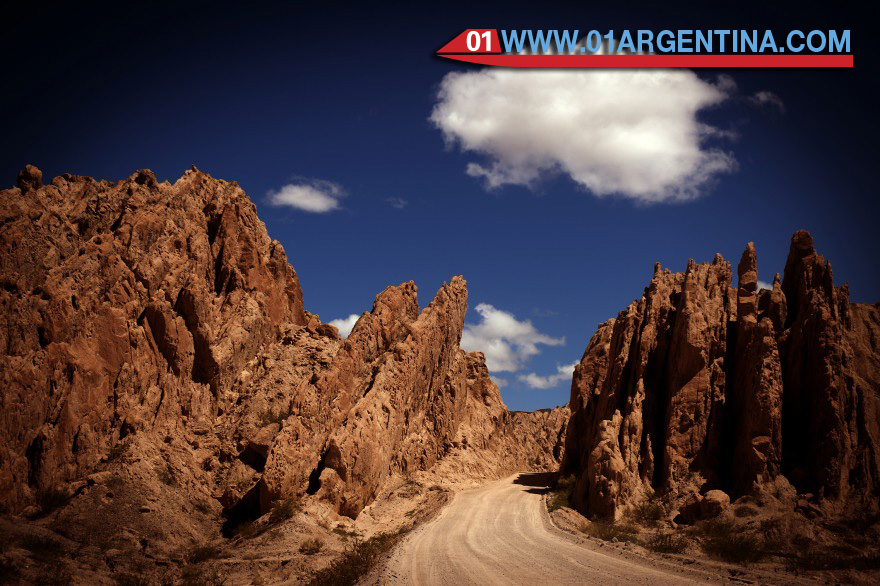
La Quebrada de Las Flechas, is a landform located at km 4380 of National Route 40 (section linking the towns of Cafayate and Cachi) in the Department San Carlos in the province of Salta north of Argentina, extending 20 km within the Valles Calchaquíes from Angastaco to Calchaquí.Distante River about 260 km from the city of Salta (Cafayate), is inclined pointy rock formations forming narrow gorges with walls 20 meters high, making one of the most attractive tourist and points of national route 40.
While the formations are crossed, they highlight the “passage of Snowdrift” and especially the “passage of the Arrow,” which to a petrified glacier sharp points, which was declared a Natural Monument Angastaco by the provincial Law No. resembles 6808 in 1995.
In his career, located at km 4420 Route 40, is the oldest Jesuit church around the Calchaquí Valley which dates from 1780. It was restored in 1969 by the current owners of the site (Finca El Carmen); made of adobe and thatched roof, with two colorful altars, the church seems to hang from a cliff, overlooking the valley in its entirety. From the place, and across the river, it can be entered between ancient rocks where archaeological remains and remains of funerary urns and vessel of santamariana culture (or culture Santa Maria), who inhabited the land before the arrival of the Spaniards are.
Geological formation
Its origins date back to between 15 to 20 million years when large boulders began to rise on the edge of the Puna. (Hard and crystalline rocks originated in the Precambrian); Deep faults in the earth’s crust were up granitic and metamorphic rocks forming a mountainous buttresses. Sedimentary plaques (reddish brown sandstones sedimented before the Andes any) that were found at some point storey were broken by the rise of the mountains and the ends were inclined pointing to the sky arming narrow canyons with walls about 20 m high. Subsequently erosion and now the sharpened blades or arrowheads resemble one beside the other.
These strata were folded and fractured to receive the thrust of the Andean orogeny; these materials eventually became rocks were classified under the name Training Angastaco, for being the place where they reach their best.
Angastaco Formation within the three sections are distinguished. The lower section predominantly sandy gray and light reddish brown, the middle section with thick sandstone and conglomerate gray and the upper section essentially subordinate sandy mudstones.
When go to Salta: weather and seasons
With an average annual temperature of 22 ° C, the weather in Salta is balmy all year, like the whole environment of the Valle de Lerma. However, there is an important thermal amplitude between the hot summer (average maximum of 32 ° C in January, cooling at night) and winter, much cooler (between 2 and 16 ° C). Fall and spring are moderate temperatures in the environment of 20 ° C. Rainfall is concentrated in summer, between December and February, reaching 1000 mm per year.
High seasons in Salta not defined by the weather as both holidays. Easter is one of the peaks of the high season, mainly by major religious tours offered. Winter holidays in July also considered high season, as many Argentines take this time to travel. Prices in high season are higher and it is essential to book tickets, accommodation and income to the main tourist sites.
What is the best time to travel to Salta
Although Salta is beautiful at any time of year, it is considered average season as the best time to travel to Salta, thanks to the excellent climate and the lack of rain. May and September months are highly recommended as it is the off season, so very nice plus for all types of day trips, you will find quite attractive promotions and tranquility to tour the sights.
Those who are interested in learning about the most deeply rooted traditions of the Salta region should take note of the main festivities in Salta. Christmas and New Year are celebrated with a colorful living nativity scene which is great appeal across the country, in what is known as “Christmas City”. On February 8 gauchos parades are held by the birth of General Martin Miguel de Guemes, while in late February Carnival is celebrated typical Salteño, with parades, dances and traditional costumes.
April is one of the months with most tourists in Salta. One reason is that the whole month “April Cultural Salteño” is done, with art activities throughout the city. Also in April, the 4th, commemorates the “Day Pie Salteña” dish originally from Salta and famous in America. The Feast of the Foundation of Salta is 16 April.








You must be logged in to post a comment.